英语感官动词
英语语法知识——感官动词

四、感官动词的被动句
授课:Shawn
考点2:感官动词的被动语态 see sb do sth = sb be seen to do
sth see sb doing sth =sb be seen
doI sinawg sththe girl come in .
=
I saw the girl dancing =
感官动词+宾语+V原 型 感官动词+宾语+Ving
感官动词+宾语+V-ed
感官动词+宾语+V原型
see sb do sth 看见某人做了某事
eg. I saw her cross the road . I heard the boy sing in the room .
感官动词+宾语+Ving
(1) I heard a child crying . (2) I smell the cake burning . (3)I find him working in the room. (4)I saw my father go away (5)I looked at him finish his homework . (6)I watched my sister's car pull in .
感官动词的用法
核心语法
授课:Shawn
目录
1
感官动词的定义
2
感官动词的常考点
3
感官动词的分类
4
感官动词的被动语态
一、感官动词的定义
授课:Shawn
verbs of perception 感官:感受外界刺激的器官
二、感官动词的分类
授课:Shawn
英语中感官动词的用法
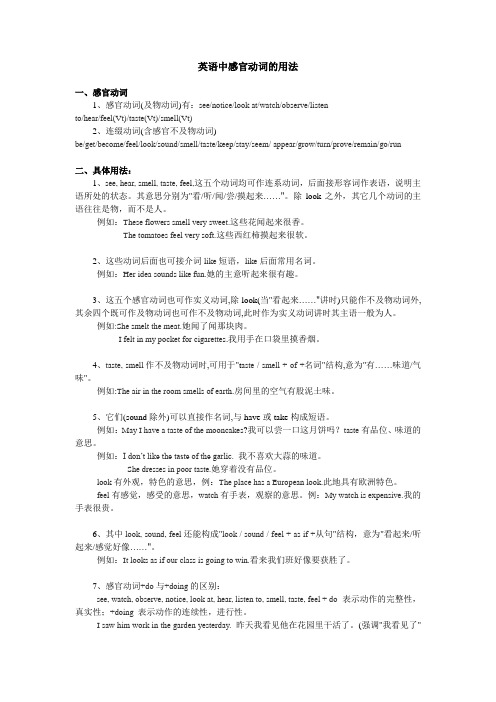
英语中感官动词的用法一、感官动词1、感官动词(及物动词)有:see/notice/look at/watch/observe/listento/hear/feel(Vt)/taste(Vt)/smell(Vt)2、连缀动词(含感官不及物动词)be/get/become/feel/look/sound/smell/taste/keep/stay/seem/ appear/grow/turn/prove/remain/go/run二、具体用法:1、see, hear, smell, taste, feel,这五个动词均可作连系动词,后面接形容词作表语,说明主语所处的状态。
其意思分别为"看/听/闻/尝/摸起来……"。
除look之外,其它几个动词的主语往往是物,而不是人。
例如:These flowers smell very sweet.这些花闻起来很香。
The tomatoes feel very soft.这些西红柿摸起来很软。
2、这些动词后面也可接介词like短语,like后面常用名词。
例如:Her idea sounds like fun.她的主意听起来很有趣。
3、这五个感官动词也可作实义动词,除look(当"看起来……"讲时)只能作不及物动词外,其余四个既可作及物动词也可作不及物动词,此时作为实义动词讲时其主语一般为人。
例如:She smelt the meat.她闻了闻那块肉。
I felt in my pocket for cigarettes.我用手在口袋里摸香烟。
4、taste, smell作不及物动词时,可用于"t aste / smell + of +名词"结构,意为"有……味道/气味"。
例如:The air in the room smells of earth.房间里的空气有股泥土味。
5、它们(sound除外)可以直接作名词,与have或take构成短语。
英语中感官动词的用法-学案--高考英语一轮复习
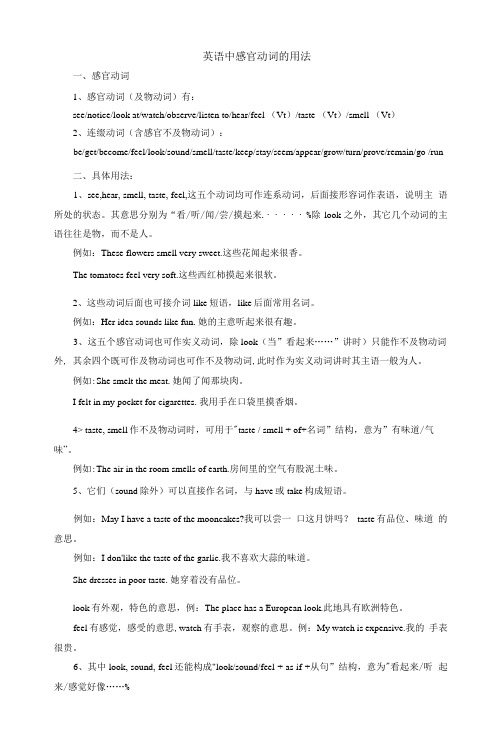
英语中感官动词的用法一、感官动词1、感官动词(及物动词)有:see/notice/look at/watch/observe/listen to/hear/feel (Vt)/taste (Vt)/smell (Vt)2、连缀动词(含感官不及物动词):be/get/become/feel/look/sound/smell/taste/keep/stay/seem/appear/grow/turn/prove/remain/go /run二、具体用法:1、see,hear, smell, taste, feel,这五个动词均可作连系动词,后面接形容词作表语,说明主语所处的状态。
其意思分别为“看/听/闻/尝/摸起来.・・・・・%除look之外,其它几个动词的主语往往是物,而不是人。
例如:These flowers smell very sweet.这些花闻起来很香。
The tomatoes feel very soft.这些西红柿摸起来很软。
2、这些动词后面也可接介词like短语,like后面常用名词。
例如:Her idea sounds like fun.她的主意听起来很有趣。
3、这五个感官动词也可作实义动词,除look(当”看起来……”讲时)只能作不及物动词外, 其余四个既可作及物动词也可作不及物动词,此时作为实义动词讲时其主语一般为人。
例如:She smelt the meat.她闻了闻那块肉。
I felt in my pocket for cigarettes.我用手在口袋里摸香烟。
4> taste, smell作不及物动词时,可用于"taste / smell + of+名词”结构,意为”有味道/气味”。
例如:The air in the room smells of earth.房间里的空气有股泥土味。
5、它们(sound除外)可以直接作名词,与have或take构成短语。
感官动词
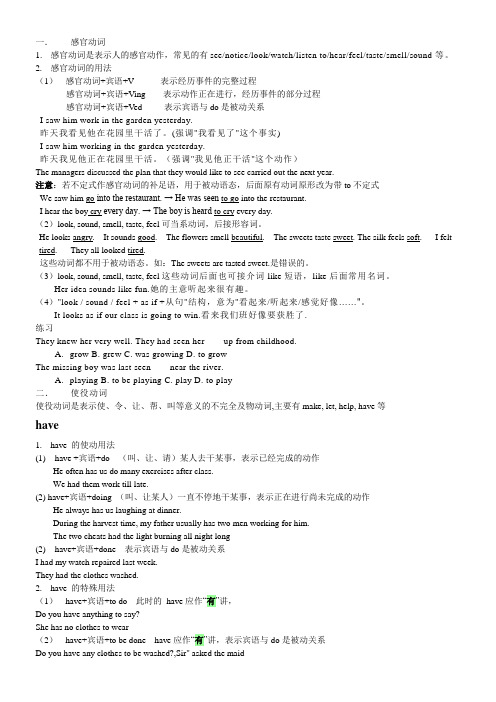
一.感官动词1.感官动词是表示人的感官动作,常见的有see/notice/look/watch/listen to/hear/feel/taste/smell/sound等。
2.感官动词的用法(1)感官动词+宾语+V 表示经历事件的完整过程感官动词+宾语+Ving 表示动作正在进行,经历事件的部分过程感官动词+宾语+Ved 表示宾语与do是被动关系I saw him work in the garden yesterday.昨天我看见他在花园里干活了。
(强调"我看见了"这个事实)I saw him working in the garden yesterday.昨天我见他正在花园里干活。
(强调"我见他正干活"这个动作)The managers discussed the plan that they would like to see carried out the next year.注意:若不定式作感官动词的补足语,用于被动语态,后面原有动词原形改为带to不定式We saw him go into the restaurant. → He was seen to go into the restaurant.I hear the boy cry every day. → The boy is heard to cry every day.(2)look, sound, smell, taste, feel可当系动词,后接形容词。
He looks angry. It sounds good. The flowers smell beautiful. The sweets taste sweet. The silk feels soft. I felt tired. They all looked tired.这些动词都不用于被动语态。
如:The sweets are tasted sweet.是错误的。
英语感官动词造句
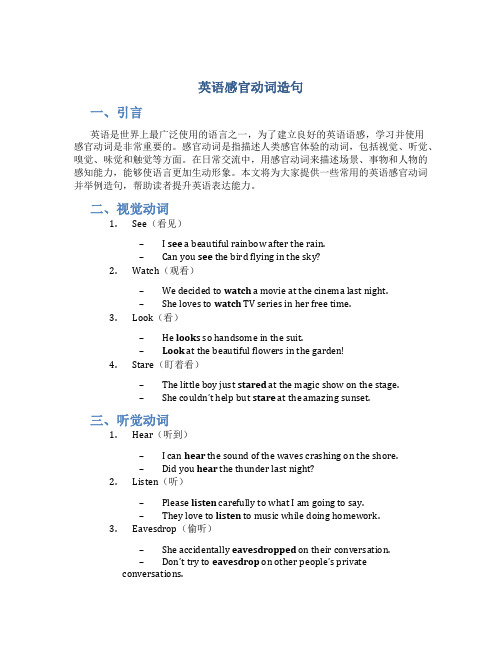
英语感官动词造句一、引言英语是世界上最广泛使用的语言之一,为了建立良好的英语语感,学习并使用感官动词是非常重要的。
感官动词是指描述人类感官体验的动词,包括视觉、听觉、嗅觉、味觉和触觉等方面。
在日常交流中,用感官动词来描述场景、事物和人物的感知能力,能够使语言更加生动形象。
本文将为大家提供一些常用的英语感官动词并举例造句,帮助读者提升英语表达能力。
二、视觉动词1.See(看见)–I see a beautiful rainbow after the rain.–Can you see the bird flying in the sky?2.Watch(观看)–We decided to watch a movie at the cinema last night.–She loves to watch TV series in her free time.3.Look(看)–He looks so handsome in the suit.–Look at the beautiful flowers in the garden!4.Stare(盯着看)–The little boy just stared at the magic show on the stage.–She couldn’t help but stare at the amazing sunset.三、听觉动词1.Hear(听到)–I can hear the sound of the waves crashing on the shore.–Did you hear the thunder last night?2.Listen(听)–Please listen carefully to what I am going to say.–They love to listen to music while doing homework.3.Eavesdrop(偷听)–She accidentally eavesdropped on their conversation.–Don’t try to eavesdrop on other people’s privateconversations.4.Overhear(无意中听到)–I overheard him talking about his travel plans.–They were shocked when they overheard their neighbors arguing.四、嗅觉动词1.Smell(闻)–I love the smell of freshly baked bread.–Can you smell the scent of flowers in the garden?2.Sniff(嗅)–The dog sniffed around the room, searching for food.–She sniffed the perfume to see if she liked it.3.Scent(嗅到)–The hunter could sense the scent of the prey nearby.–The bakery is filled with the scent of freshly brewed coffee.4.Inhale(吸入)–She closed her eyes and inhaled the refreshing ocean breeze.–It’s important to inhale deeply when practicing yoga.五、味觉动词1.Taste(尝)–The soup tastes very delicious.–Have you tasted the new flavor of ice cream?2.Try(尝试)–He decided to try the spicy food even though he couldn’t handle it.–Don’t forget to try the local cuisine when you travel.3.Savor(品味)–She savored every bite of the chocolate cake.–Take your time to savor the flavors of the dish.4.Sample(品尝)–The waiter offered to sample the different wines before ordering.–They sampled various types of cheese during the tasting event.六、触觉动词1.Touch(触摸)–The soft fur made her want to touch the cute little puppy.–She hesitated to touch the prickly cactus.2.Feel(感受)–We all feel excited about the upcoming vacation.–Can you feel the warmth of the sun on your skin?3.Hold(握住)–He gently held her hand as they walked along the beach.–The child held the balloon tightly, afraid of letting it go.4.Embrace(拥抱)–They finally met after a long time and shared a warm embrace.–The mother embraced her child tightly to show her love.七、结论通过运用感官动词,我们可以更加生动地描述我们与世界的感知和互动。
初中英语感官动词的用法
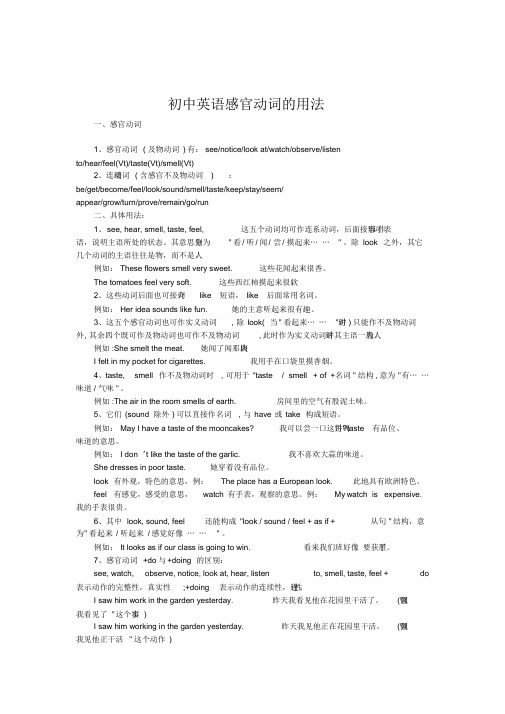
初中英语感官动词的用法一、感官动词1、感官动词( 及物动词) 有:see/notice/look at/watch/observe/listento/hear/feel(Vt)/taste(Vt)/smell(Vt)2、连缀动词( 含感官不及物动词) :be/get/become/feel/look/sound/smell/taste/keep/stay/seem/appear/grow/turn/prove/remain/go/run二、具体用法:1、see, hear, smell, taste, feel, 这五个动词均可作连系动词,后面接形容词作表语,说明主语所处的状态。
其意思分别为" 看/ 听/ 闻/ 尝/ 摸起来⋯⋯" 。
除look 之外,其它几个动词的主语往往是物,而不是人。
例如:These flowers smell very sweet. 这些花闻起来很香。
The tomatoes feel very soft. 这些西红柿摸起来很软。
2、这些动词后面也可接介词like 短语,like 后面常用名词。
例如:Her idea sounds like fun. 她的主意听起来很有趣。
3、这五个感官动词也可作实义动词, 除look( 当" 看起来⋯⋯"讲时) 只能作不及物动词为人。
时其主语一般外, 其余四个既可作及物动词也可作不及物动词, 此时作为实义动词讲。
例如:She smelt the meat. 她闻了闻那块肉I felt in my pocket for cigarettes. 我用手在口袋里摸香烟。
4、taste, smell 作不及物动词时, 可用于"taste / smell + of +名词" 结构, 意为"有⋯⋯味道/ 气味" 。
例如:The air in the room smells of earth. 房间里的空气有股泥土味。
初中英语语法专题---感官动词(共15张PPT)

模块语法聚焦一
( )11.—Do you like swimming in winter? —Of course. The water ________ a bit cold at first, but then I am warm and full of energy. A.tastes B.feels C.smells D.looks ( )12.Mum is making dinner. It ________ so nice! A.smells B.tastes C.feels D.sounds
He looks tired.
他看起来累了。
These flowers smell sweet.
这些花闻起来香。
模块语法聚焦一
Her voice sounds beautiful. 她的声音听起来优美。 The cake tastes delicious.蛋糕尝起来美味。 I felt guilty.我感到内疚。 3.感官动词后可接介词like, like后可接名词或v.ing 形式。例如: That boat looks like a duck. 那条船看起来像一只鸭子。 It smells like being burnt.它闻起来像烧焦了一样。
[答案] 13D,14C,15C
模块语法聚焦一
Ⅱ.根据汉语意思完成句子 1.我的毛衣摸起来柔软。 My sweater ___f_e_e_l_s_s_o__ft_. 2.聚会听起来太吵了。 The party __s_o_u_n_d_s__n_o_i_s_y_______. 3.你妈妈看上去很年轻。 Your mother _____L_o_o_k_s__y_o_u_n_g_______. 4.汤尝起来咸了。 The soup ____T_a_s_t_e_s__s_a_l_t_y____. 5.它闻起来新鲜吗? __D_o_e_s__ it __s_m_e_l_l___f_r_e_s_h__?
初二英语感官动词用法单选题30题
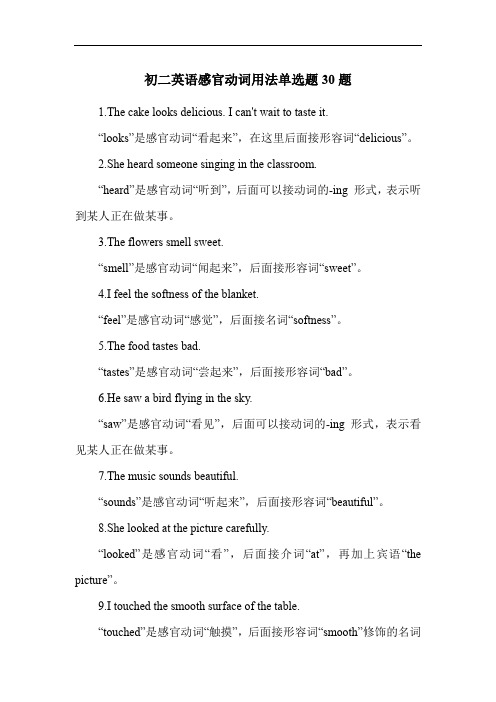
初二英语感官动词用法单选题30题1.The cake looks delicious. I can't wait to taste it.“looks”是感官动词“看起来”,在这里后面接形容词“delicious”。
2.She heard someone singing in the classroom.“heard”是感官动词“听到”,后面可以接动词的-ing 形式,表示听到某人正在做某事。
3.The flowers smell sweet.“smell”是感官动词“闻起来”,后面接形容词“sweet”。
4.I feel the softness of the blanket.“feel”是感官动词“感觉”,后面接名词“softness”。
5.The food tastes bad.“tastes”是感官动词“尝起来”,后面接形容词“bad”。
6.He saw a bird flying in the sky.“saw”是感官动词“看见”,后面可以接动词的-ing 形式,表示看见某人正在做某事。
7.The music sounds beautiful.“sounds”是感官动词“听起来”,后面接形容词“beautiful”。
8.She looked at the picture carefully.“looked”是感官动词“看”,后面接介词“at”,再加上宾语“the picture”。
9.I touched the smooth surface of the table.“touched”是感官动词“触摸”,后面接形容词“smooth”修饰的名词“surface”。
10.The water feels cold.“feels”是感官动词“感觉”,后面接形容词“cold”。
11.The students heard the teacher sing an English song yesterday. But today they hear the teacher_____a Chinese song.A.singB.sangC.singingD.to sing答案:C。
feel做感官动词的用法
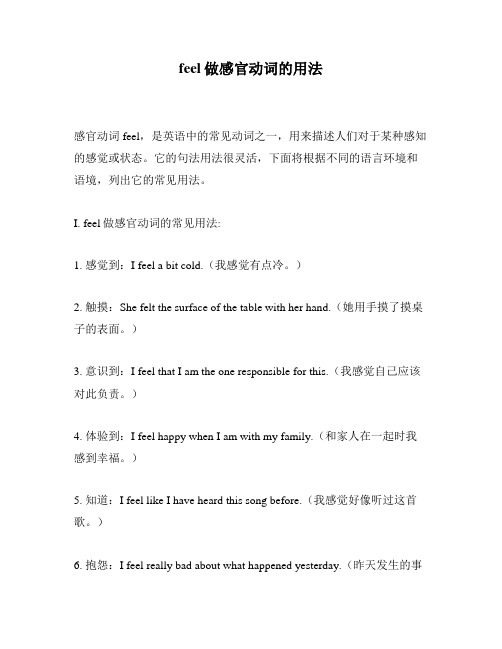
feel做感官动词的用法感官动词feel,是英语中的常见动词之一,用来描述人们对于某种感知的感觉或状态。
它的句法用法很灵活,下面将根据不同的语言环境和语境,列出它的常见用法。
I. feel做感官动词的常见用法:1. 感觉到:I feel a bit cold.(我感觉有点冷。
)2. 触摸:She felt the surface of the table with her hand.(她用手摸了摸桌子的表面。
)3. 意识到:I feel that I am the one responsible for this.(我感觉自己应该对此负责。
)4. 体验到:I feel happy when I am with my family.(和家人在一起时我感到幸福。
)5. 知道:I feel like I have heard this song before.(我感觉好像听过这首歌。
)6. 抱怨:I feel really bad about what happened yesterday.(昨天发生的事情让我感到很糟糕。
)7. 判断:From her tone of voice, I feel that she is not happy.(从她的语气来判断,我感觉她不高兴。
)8. 猜想:I feel that he might be lying.(我猜他可能在说谎。
)II. feel作为不及物动词时的常见用法:1. 感到:I feel happy.(我感觉很快乐。
)2. 检查:Can you feel if there is any pulse?(你能检查下有没有脉搏吗?)3. 试探:I need to feel him out before I make any decision.(我需要试探一下他才能做出任何决定。
)4. 穿戴:I feel comfortable in these clothes.(穿这些衣服我觉得很舒服。
module1-感官动词讲解ppt课件
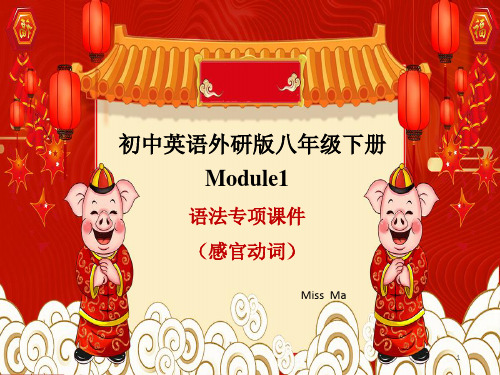
语法专项课件 (感官动词)
Miss Ma
1
Part
语法透析
考点大观 易错辨析 通关训练
2
语法透视
考点大观
感官动词
感官动词四注意: ➢感官动词表示感觉和知觉
视觉
Eye
look
嗅觉
Nose smell
听觉
Ear
sound
味觉 Mouth taste
触觉
Hand
Tom __lo_o_k_s_v_e_r_y__u_n_h_a_p_p_y____. 4. 别不好意思,试一试。
Don’t be shy, just __h_a_v_e__a_t_r_y_____.
Next
语法透视
考点大观 易错辨析 通关训练
解析
Next
The vegetable soup_____ delicious. Can I have more? A. looks B. tastes C. sounds D. feels
【解析】本句话意为“这个蔬菜汤尝起来太美味 了,我能再来一碗吗?”。考察“系表结构”, 表示“尝”,所以答案选B。
The cookies smell delicious. The soup tastes too salty. The bed feels hard. The idea sounds quite good. All the children look happy. 上面用到的系动词smell, taste, feel, sound, look相当于汉语中的闻起来,尝 起来,摸上去,听上去,看起来的概念。
C. 完成句子: 1. 丝绸摸起来很柔软。 Silk ___________________. 2. 洋葱不好吃,气味太浓了。 The onion doesn’t taste good, it _________________. 3. 汤姆看起来不开心。 Tom _____________________. 4. 别不好意思,试一试。 Don’t be shy, just _______________.
高考感官动词用法总结

高考感官动词用法总结在高考英语中,感官动词是一个重要的语法点。
掌握好感官动词的用法,对于理解和运用英语语言有着重要的意义。
下面我们就来详细总结一下高考中常见的感官动词用法。
一、常见的感官动词常见的感官动词有:see(看见)、watch(观看)、look at(看)、hear(听见)、listen to(听)、feel(感觉)、smell(闻)、taste(尝)等。
二、感官动词的用法1、感官动词+宾语+宾语补足语(1)感官动词+宾语+ do(表示动作的全过程,强调结果或经常性的动作)例如:I saw him cross the road(我看见他过了马路。
)We often hear her sing in the room(我们经常听见她在房间里唱歌。
)(2)感官动词+宾语+ doing(表示动作正在进行)例如:I saw him crossing the road when I passed by(我路过时看见他正在过马路。
)I heard her singing in the room at that time(那时我听见她正在房间里唱歌。
)(3)感官动词+宾语+ done(表示宾语与宾语补足语之间是被动关系)例如:I saw the window broken(我看见窗户被打破了。
)We found the tree cut down(我们发现树被砍倒了。
)2、感官动词+宾语从句例如:I saw that he crossed the road safely(我看见他安全地过了马路。
)She heard that someone was knocking at the door(她听见有人在敲门。
)3、感官动词的被动语态感官动词在被动语态中,其后的宾语补足语要用带 to 的不定式。
例如:He was seen to cross the road(有人看见他过了马路。
)The girl was heard to sing in the room(有人听见这个女孩在房间里唱歌。
感官动词英语

感官动词英语英语中的感官动词象征着五官的感知,它是用来表达人类感觉体验的言语,具有重要意义。
下面要讨论的是英语中的感官动词,以及它们在使用时应该如何正确表达。
英语中的感官动词可分为五组,分别代表着人类五官的感知。
具体来说,有看、听、嗅、触、和尝五种不同的感官动词。
其中,“看”(see)表示“看见”(view),“听”(hear)表示“听到”(listen),“嗅”(smell)表示“闻到”(smell),“触”(touch)表示“摸、触摸”(touch),“尝”(taste)则表示“尝到”(taste)。
感官动词可以用来表达周围的景物和声音,可以用来描述被观察者的感受。
它们可以被用来把观察者从现实环境中带出,帮助其了解感受。
一个正确的使用感官动词的词句可以使被观察者更加真实的感受到所描绘的环境。
除了表达外部的景物和声音之外,感官动词还可以表达人类的内在感受或心理活动。
对于澳大利亚朋友来说,他们可能会用see 来表达“感受到”的意思,而他们的美国朋友则会用feel来表达这个意思。
感官动词只是表达某种情感或感受的一种方式,为此,它们可以被自由灵活地使用。
并不是所有的感官动词都可以用来表达观察者的感受。
当感官动词被运用到一定情况之中时,它们可能会有不同的意思。
例如当感官动词被用来表达对一个物体的质量时,它们可能表达的是不同的意思,比如smell表示的是物体的气味,而touch表示的是物体的质地。
以上就是英语中的感官动词及其正确使用方法的简介。
感官动词是英语中一种重要的表达方式,帮助人们更好的理解外界的景物和声音,以及更加真实的感受被观察者的感受。
使用感官动词可以帮助人们更好的表达自己的感受,增加语言表达的精细度,使沟通更加流畅顺畅。
英语中的感官动词的用法
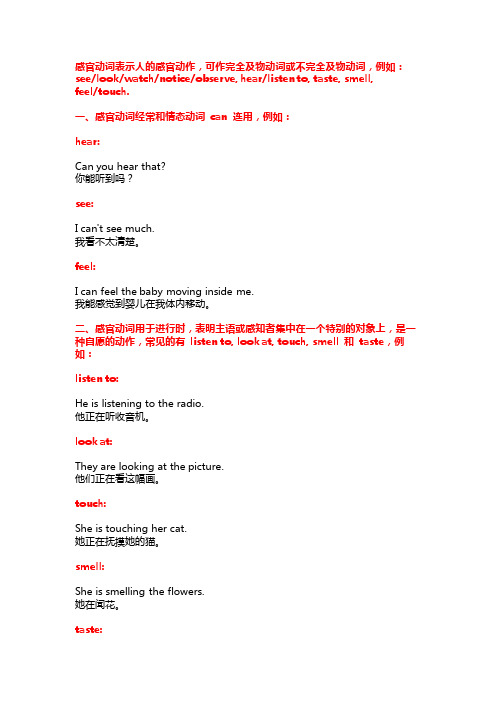
感官动词表示人的感官动作,可作完全及物动词或不完全及物动词,例如:see/look/watch/notice/observe, hear/listen to, taste, smell,feel/touch.一、感官动词经常和情态动词can 连用,例如:hear:Can you hear that?你能听到吗?see:I can't see much.我看不太清楚。
feel:I can feel the baby moving inside me.我能感觉到婴儿在我体内移动。
二、感官动词用于进行时,表明主语或感知者集中在一个特别的对象上,是一种自愿的动作,常见的有listen to, look at, touch, smell 和taste,例如:listen to:He is listening to the radio.他正在听收音机。
look at:They are looking at the picture.他们正在看这幅画。
touch:She is touching her cat.她正在抚摸她的猫。
smell:She is smelling the flowers.她在闻花。
taste:We are tasting champagne.我们正在品尝香槟。
并不是所有的感官动词都可以用进行时,例如:误:She was hearing a noise.误:He was seeing a woman in the rain.但当hear 在表达一种经历时,可以用进行时;see 在表达与人见面或是约会,可以用进行时,等等,例如:hearing:She was always hearing voices in her head.她脑子里总有声音。
seeing:She is seeing the doctor.她正在看医生。
He was seeing another woman.他在和另一个女人约会。
英语学习-什么是感官动词用法如何
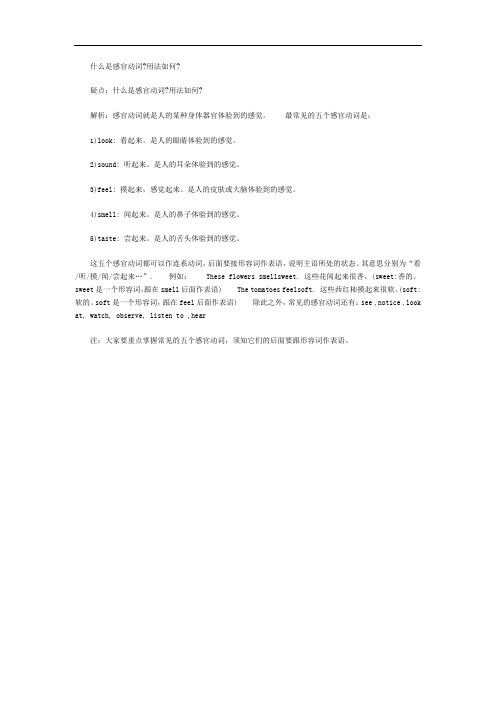
什么是感官动词?用法如何?
疑点:什么是感官动词?用法如何?
解析:感官动词就是人的某种身体器官体验到的感觉。
最常见的五个感官动词是:
1)look: 看起来。
是人的眼睛体验到的感觉。
2)sound: 听起来。
是人的耳朵体验到的感觉。
3)feel: 摸起来,感觉起来。
是人的皮肤或大脑体验到的感觉。
4)smell: 闻起来。
是人的鼻子体验到的感觉。
5)taste: 尝起来。
是人的舌头体验到的感觉。
这五个感官动词都可以作连系动词,后面要接形容词作表语,说明主语所处的状态。
其意思分别为“看/听/摸/闻/尝起来…”.例如:These flowers smellsweet. 这些花闻起来很香。
(sweet:香的。
sweet是一个形容词,跟在smell后面作表语) The tomatoes feelsoft. 这些西红柿摸起来很软。
(soft:软的。
soft是一个形容词,跟在feel后面作表语) 除此之外,常见的感官动词还有:see ,notice ,look at, watch, observe, listen to ,hear
注:大家要重点掌握常见的五个感官动词,须知它们的后面要跟形容词作表语。
感官动词用法
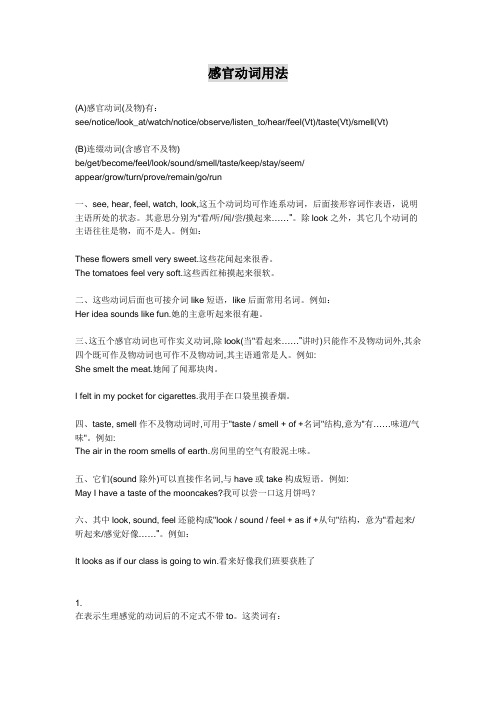
感官动词用法(A)感官动词(及物)有:see/notice/look_at/watch/notice/observe/listen_to/hear/feel(Vt)/taste(Vt)/smell(Vt)(B)连缀动词(含感官不及物)be/get/become/feel/look/sound/smell/taste/keep/stay/seem/appear/grow/turn/prove/remain/go/run一、see, hear, feel, watch, look,这五个动词均可作连系动词,后面接形容词作表语,说明主语所处的状态。
其意思分别为"看/听/闻/尝/摸起来……"。
除look之外,其它几个动词的主语往往是物,而不是人。
例如:These flowers smell very sweet.这些花闻起来很香。
The tomatoes feel very soft.这些西红柿摸起来很软。
二、这些动词后面也可接介词like短语,like后面常用名词。
例如:Her idea sounds like fun.她的主意听起来很有趣。
三、这五个感官动词也可作实义动词,除look(当"看起来……"讲时)只能作不及物动词外,其余四个既可作及物动词也可作不及物动词,其主语通常是人。
例如:She smelt the meat.她闻了闻那块肉。
I felt in my pocket for cigarettes.我用手在口袋里摸香烟。
四、taste, smell作不及物动词时,可用于"taste / smell + of +名词"结构,意为"有……味道/气味"。
例如:The air in the room smells of earth.房间里的空气有股泥土味。
五、它们(sound除外)可以直接作名词,与have或take构成短语。
英语感官动词的用法(一)
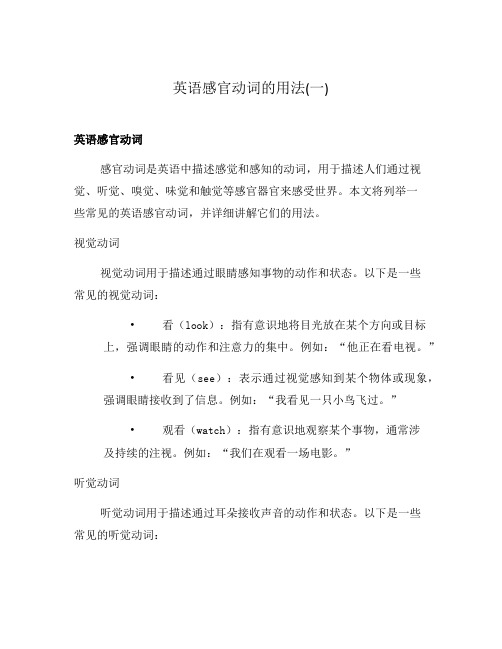
英语感官动词的用法(一)英语感官动词感官动词是英语中描述感觉和感知的动词,用于描述人们通过视觉、听觉、嗅觉、味觉和触觉等感官器官来感受世界。
本文将列举一些常见的英语感官动词,并详细讲解它们的用法。
视觉动词视觉动词用于描述通过眼睛感知事物的动作和状态。
以下是一些常见的视觉动词:•看(look):指有意识地将目光放在某个方向或目标上,强调眼睛的动作和注意力的集中。
例如:“他正在看电视。
”•看见(see):表示通过视觉感知到某个物体或现象,强调眼睛接收到了信息。
例如:“我看见一只小鸟飞过。
”•观看(watch):指有意识地观察某个事物,通常涉及持续的注视。
例如:“我们在观看一场电影。
”听觉动词听觉动词用于描述通过耳朵接收声音的动作和状态。
以下是一些常见的听觉动词:•听(listen):指有意识地接收声音,通常涉及专注和用心倾听。
例如:“他正在听音乐。
”•听到(hear):表示通过听觉感知到声音,强调耳朵接收到了信息。
例如:“我听到有人敲门。
”•倾听(attend):指专心地听某人讲话或某个声音,通常涉及配合眼神或姿势表达出对信息的注意。
例如:“她倾听着老师的讲解。
”嗅觉动词嗅觉动词用于描述通过鼻子嗅到气味的动作和状态。
以下是一些常见的嗅觉动词:•闻(smell):指有意识地嗅到气味,强调鼻子接收到了信息。
例如:“我闻到了鲜花的香味。
”•嗅到(detect):表示通过嗅觉感知到某种气味,强调鼻子接收到了信息。
例如:“狗的嗅觉比人敏锐,可以嗅到地底下的气味。
”•嗅觉敏锐(have a keen sense of smell):表示某人嗅觉灵敏,能够辨别出不同的气味。
例如:“猎犬具有嗅觉敏锐的特点。
”味觉动词味觉动词用于描述通过舌头尝到味道的动作和状态。
以下是一些常见的味觉动词:•尝(taste):指有意识地品尝食物或液体,强调舌头接收到了味道的信息。
例如:“他尝了一口咖啡。
”•感到苦(taste bitter):表示尝到苦味,强调味觉感受。
英语感官动词用法大全
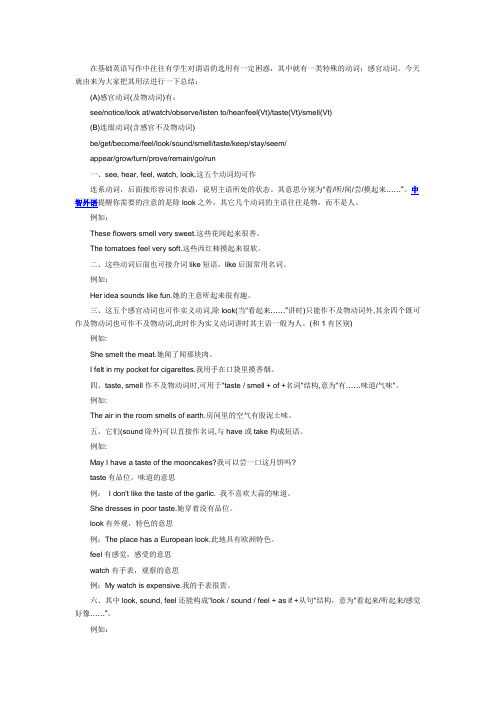
在基础英语写作中往往有学生对谓语的选用有一定困惑,其中就有一类特殊的动词:感官动词。
今天就由来为大家把其用法进行一下总结:(A)感官动词(及物动词)有:see/notice/look at/watch/observe/listen to/hear/feel(Vt)/taste(Vt)/smell(Vt)(B)连缀动词(含感官不及物动词)be/get/become/feel/look/sound/smell/taste/keep/stay/seem/appear/grow/turn/prove/remain/go/run一、see, hear, feel, watch, look,这五个动词均可作连系动词,后面接形容词作表语,说明主语所处的状态。
其意思分别为"看/听/闻/尝/摸起来……"look之外,其它几个动词的主语往往是物,而不是人。
例如:These flowers smell very sweet.这些花闻起来很香。
The tomatoes feel very soft.这些西红柿摸起来很软。
二、这些动词后面也可接介词like短语,like后面常用名词。
例如:Her idea sounds like fun.她的主意听起来很有趣。
三、这五个感官动词也可作实义动词,除look(当"看起来……"讲时)只能作不及物动词外,其余四个既可作及物动词也可作不及物动词,此时作为实义动词讲时其主语一般为人。
(和1有区别) 例如:She smelt the meat.她闻了闻那块肉。
I felt in my pocket for cigarettes.我用手在口袋里摸香烟。
四、taste, smell作不及物动词时,可用于"taste / smell + of +名词"结构,意为"有……味道/气味"。
例如:The air in the room smells of earth.房间里的空气有股泥土味。
感官动词类单词(8个)
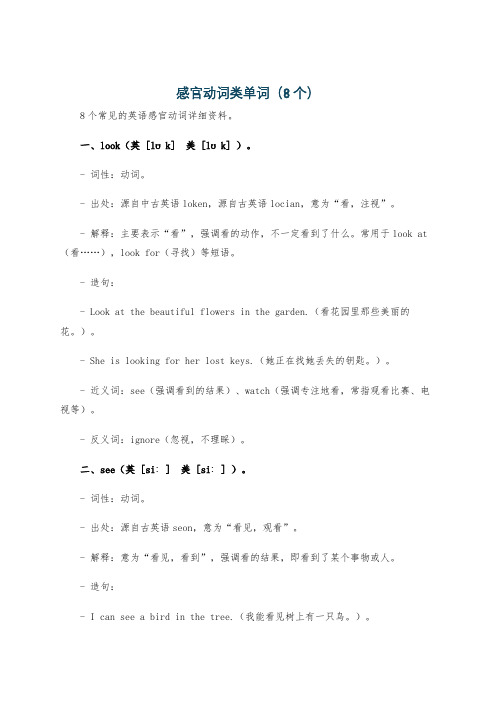
感官动词类单词(8个)8个常见的英语感官动词详细资料。
一、look(英 [lʊk] 美 [lʊk] )。
- 词性:动词。
- 出处:源自中古英语loken,源自古英语locian,意为“看,注视”。
- 解释:主要表示“看”,强调看的动作,不一定看到了什么。
常用于look at (看……),look for(寻找)等短语。
- 造句:- Look at the beautiful flowers in the garden.(看花园里那些美丽的花。
)。
- She is looking for her lost keys.(她正在找她丢失的钥匙。
)。
- 近义词:see(强调看到的结果)、watch(强调专注地看,常指观看比赛、电视等)。
- 反义词:ignore(忽视,不理睬)。
二、see(英 [siː] 美 [siː] )。
- 词性:动词。
- 出处:源自古英语seon,意为“看见,观看”。
- 解释:意为“看见,看到”,强调看的结果,即看到了某个事物或人。
- 造句:- I can see a bird in the tree.(我能看见树上有一只鸟。
)。
- She saw her friend at the supermarket yesterday.(她昨天在超市看见了她的朋友。
)。
- 近义词:notice(注意到)。
- 反义词:miss(错过,没看见)。
三、hear(英 [hɪə(r)] 美 [hɪr] )。
- 词性:动词。
- 出处:源自古英语hieran,意为“听,听见”。
- 解释:表示“听见,听到”,强调听的结果,即听到了声音。
- 造句:- I can hear the birds singing in the morning.(我能听到鸟儿在早晨唱歌。
)。
- She heard the doorbell ring.(她听到门铃响了。
)。
- 近义词:listen to(强调听的动作)。
- 反义词:deaf(聋的,听不到的)。
- 1、下载文档前请自行甄别文档内容的完整性,平台不提供额外的编辑、内容补充、找答案等附加服务。
- 2、"仅部分预览"的文档,不可在线预览部分如存在完整性等问题,可反馈申请退款(可完整预览的文档不适用该条件!)。
- 3、如文档侵犯您的权益,请联系客服反馈,我们会尽快为您处理(人工客服工作时间:9:00-18:30)。
精品课件
ቤተ መጻሕፍቲ ባይዱ
look/smell/ taste
The soup smells delicious. -- The soup doesn’t smell delicious. --Does it smell delicious? --Yes/No,…
The flowers look beautiful. The flowers don’t look beautiful. --Do they look beautiful? --Yes/No,… --How do the flowers …?
Module7
Unit 1 That smells delicious
1.Revise the new words in Unit 1. 2.Learn the important phrases and the sentences. 3.Do some exercises.
Revise the new words
精品课件
How does it feel? Itf_e_e_l_s_(摸起来 )soft (柔软的) and comfortable(舒服的).
We use our _h_a_n_d_s to feel.
How does she feel(感觉)? She __f_e_e_l_ssad.
How does she feel? She feels_h_a_p_p_y_.
Step1 Look, guess and talk How does he look? He __l_o_o_k_sstrong
We use our _e_y_e_s_ to look.
How does it smell? Itsm_e_l_l_s_闻( 起来 ) delicious.
I smell with myno_s_e____.
Ling ling’s sweater feels soft and com
7.Who looks smart?
Ling and Betty look smart.
Step 4 Explore
含有感官系动 词的句子结构
是什么?
主语+感官系动词+形容词
精品课件
其否定式和疑 问式应如何变
换?
与be动词不同,其构成要 加助动词does或do
salty
(咸的)
Step 3 Read ,ask and answer in pairs. 1.What smells delicious?
The pizza smells delicious.
2.What doesn’t smell fresh?
The cheese doesn’t smell fresh.
smell feel sound
fresh(新鲜的), sour(酸的)
delicious,
soft (柔软的),tight(紧的) comfortabl(e舒服的),
nice, quiet, beautiful
taste
sweet Delicious, strong, fresh
sour,
(甜的),
How does it taste? It_t_a_s_t_e_s delicious.
I taste with mmyou_t_h____.
Step2 Read ,learn and match
look Smart, pretty, strong(强壮)
hand eye nose mouth ear
Step6Summary
1、look,smell, taste,sound,feel
2、Key structure:sense verbs+ adj.
结语
精品课件
1.Do the exercises 2and 4 on page 136 in the workbook.
2. Preview the new words in Unit2.
strong
delicious,sweet
It tastes delicious. It doesn’t taste … Does it…?Yes/No, …
How does it feel/look/sound/taste/smell?
Step 5 Test
feel look smell sound taste
3.What tastes sweet?
The chocolate cookies taste sweet.
4.Who looks pretty?
Sally looks pretty.
5.Who sounds nice?
Sally sounds nice.
6.What feels soft and comfortable?
